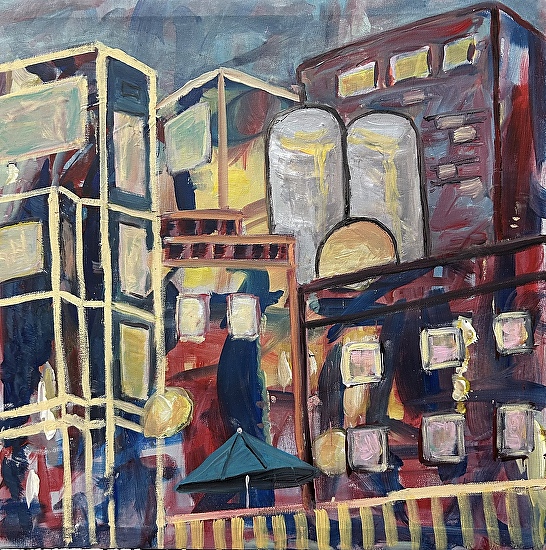

Embrace Boredom!
The photo on the left is taken from Jake’s cafe patio. The painting on the right is a work-in-progress, an outline of what might eventually emerge on my canvas. I’ve been working on it for two days and have no idea what it will look like when finished. Though it has a long way to go, the incomplete work is an example of the creative process in action, a process that keeps me from being bored.
The various angles of the buildings struck me while dining outside. They formed an exciting yet confusing hodgepodge I couldn’t wait to put on canvas. The sun reflected off some of the windows and walls, making the images blow hot and cold. Dark green foliage appeared yellow with intense light brightening its leaves. It reminded me of looking for my car at night when the overhead lights made my red Toyota appear blue. I was convinced someone had stolen it.
Creative people don’t stay bored because boredom and creativity are opposing states of mind. Instead, they are forever curious; they meditate on mundane happenings and look closely at idiosyncrasies in the natural world. They let their imagination run wild.
Children are often taught that boredom comes from ignorance and a lack of imagination. Parents tell bored offspring to get off their duff and do something productive. Because they don’t like moping children who sit around doing nothing, they book them up with extra curricula classes and camps. They look the other way when they spend hours at the computer playing games or browsing social media. It’s less of a bother than having them engage in creative endeavors that demand their involvement.
Isn’t it possible that boredom is the path to the imagination? Boredom is often the first step to creating a dream that you want to follow. A farmer’s daughter told me she made up stories while doing routine tedious tasks as a child. She started writing them down when she had a free moment afterward. Today she is a productive, published writer on her way to fame.
Two of my children were in middle school when self-directed learning was the rage. I put them in a “school within a school” with an unregulated curriculum. They could choose when, what, and how to participate in academic, social, physical, and creative activities. Most of the year, they sat on pillows reading comic books, doing puzzles, chatting with friends, or staring into space. By the time the trees were budding in the spring, they had had enough of doing nothing and asked if they could enroll in the regular academic program the following year. I was surprised and said it was fine, but they had to make up for the year’s loss to be in the next grade with their friends. It took three months to complete the year’s curriculum. The following semester they aced their courses and engaged in various creative activities. I consider the year of boredom as having contributed to their successful careers. It helped them figure out who they were, how they learned, and it motivated them to engage in productive endeavors.
Raising children helped me realize how boredom sparks the creative process. Adults have transportation, access to information, and money to help them overcome lethargy and engage in activities that enrich their lives. Children are less mobile. They have to be surrounded at home by opportunities they can grab onto. Books, art materials, hammers and screwdrivers, sports equipment, science kits, and an adult willing to answer questions are tools that help them combat boredom. Though there are extracurricular camps and classes designed to promote creative thinking, they are very expensive. On average, a one-week summer camp costs $ 450. Overnight camps are $800 for a full week.
Many families that can’t afford such luxuries take refuge in computer games and social media. Unfortunately, so much screen time makes children less willing to engage in the creative process. It’s easier to respond to a text with an emoji or to spend hours playing games someone else designed than to hone your writing skills in a letter and make up your own game. Computer activities require reactive thinking rather than the active thinking needed for creativity. A full life requires both sides of the brain to be developed equally.
Yes, we all need downtime, and the computer has non-threatening activities to occupy yourself if trapped at home as we all were during COVID. It may get you through the day, but do you go to bed happy, satisfied that you accomplished something? Does it challenge you to learn and grow? Creative endeavors are more satisfying because they build skills that let you expand your horizon.
Researchers at the University of Arizona suggest that creative people don’t need a smartphone or streaming service to stay entertained. When they have downtime during the day and are bored, they explore their mind by allowing one idea to lead to another. During COVID-19, creative people tended to be more engaged with their thoughts and less bored as a result.
I suggest adding balance to your waking hours. Get away from the screen with physical and mentally challenging activities. Walk in nature. Ask questions. Meditate about a future filled with opportunity and be wary of activities that are reactive in nature. Find time for your brain to wander over the curious things and occurrences that made up your day. Though it may seem like a waste of time, an active imagination can lead to projects that fully engage you.
References:
Angello, A. (2022) You Can’t Have Creativity Without Boredom. Literary Hub. retrieved from BOREDOM
Anderer, J. (2023) Screen-free fun: Creative people enjoy moments of boredom more than others. StudyFInds. retrieved from https://studyfinds.org/creative-people-enjoy-idle-time/
